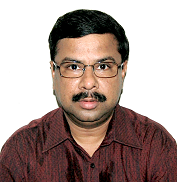










|
Title of Talk Transport of H+ and OH- ions through water wires in narrow pores
Abstract The transport of H+ and OH- ions through hydrogen bonded water wires in narrow pores is investigated by means of ab initio and combined quantum-classical simulations1,2 and population correlation function3 approaches. In particular, we focus on the mechanism and kinetics of transport of these ions through one dimensional water chains and we correlate the observed kinetics to the solvation structure of the ions and also to the dynamics of hydrogen bond fluctuations in their surroundings. In addition to one dimensional water wires in narrow carbon nanotubes4, we have also considered aqueous systems in two dimensions such as a monolayer of water molecules confined between two graphene plates4. The kinetics and mechanism of proton transfer and diffusion of H+ and OH- ions in these lower dimensional systems are compared with those in bulk aqueous solutions.
References: 1. R. Car and M. Parrinello, Phys. Rev. Lett. 1985, 55, 2471; J. Hutter, A. Alavi, T. Deutsch, M. Bernasconi, S. Goedecker, D. Marx, M. Tuckerman and M. Parrinello, CPMD Program, MPI fuer Festkorperforschung and IBM Zurich Research Laboratory 2. A. Laio, J. Vandevondele and U. Rothlisberger, J. Chem. Phys. 2002, 116, 6941; J. Phys. Chem. B 2002, 106, 7300 3. A. Chandra, Phys. Rev. Lett. 2000, 85, 768; A. Chandra, M. Tuckerman and D. Marx, Phys. Rev. Lett. 2007, 99, 145901 4. A. Bankura and A. Chandra, J. Phys. Chem. B, 2012, 116, 9744; A. Bankura and A. Chandra, to be published. |
|
Amalendu Chandra, Professor
Department of Chemistry Indian Institute of Technology Kanpur Kanpur – 208016, INDIA e-mail: amalen@iitk.ac.in
Profile. Amalendu Chandra received his B.Sc and M.Sc. from the University of Burdwan, India, in 1984 and 1986, respectively, and his Ph.D. from Indian Institute of Science, Bangalore, in 1991. He was an Izaak Walton Killam postdoctoral fellow at the University of British Columbia for two years before joining the faculty of Department of Chemistry, Indian Institute of Technology Kanpur, in 1993. He is currently holding the position of Sajani Kumar Roy Memorial Chair Professor at IIT Kanpur. He is a Fellow of Indian Academy of Sciences, Bangalore, and Indian National Science Academy, New Delhi. He received the Shanti Swarup Bhatnagar Prize from the Council of Scientific and Industrial Research in 2007 and J.C. Bose National Fellowship from the Department of Science and Technology in 2013. His research interests include theoretical and computational studies of chemical dynamics in liquids, interfaces and clusters using both classical and quantum methods
Selected Publications 1. A. Chandra, Phys. Rev. Lett. 2000, 85, 768 2. S. Senapati and A. Chandra, J. Phys. Chem. B 2001, 105, 5106 3. A. Chandra and D. Marx, Angew. Chem. Int. Ed. 2007, 46, 3676 4. A. Chandra, M. Tuckerman and D. Marx, Phys. Rev. Lett. 2007, 99, 145901 5. B. S. Mallik, A. Semparithi and A. Chandra, J. Phys. Chem. A 2008, 112, 5104 6. D. Marx, A. Chandra and M.E. Tuckerman, Chem. Rev. 2010, 110, 2174 7. Arindam Bankura and A. Chandra, J. Phys. Chem. B, 2012, 116, 9744 8. Vivek K. Yadav and A. Chandra, J. Chem. Phys. 2013, 138, 224501 |
